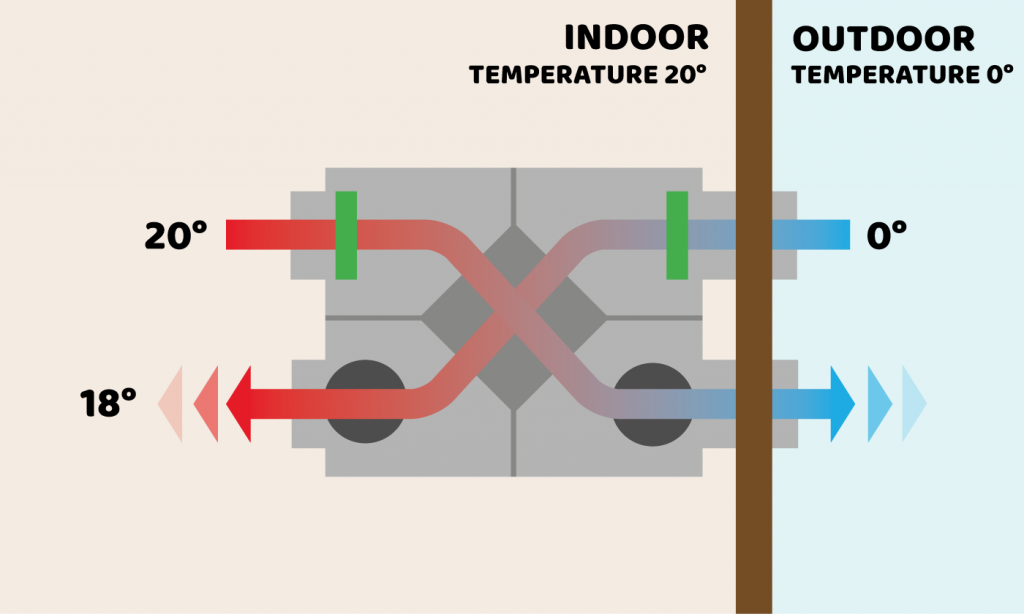HRV For Beginners: Why It Matters
Wiki Article
The All-Inclusive Guide to the Uses of Heat Recovery Ventilation in Modern Structures
Heat Recovery Ventilation (HRV) systems stand for a substantial development in developing technology (HRV Heat Recovery Ventilation). They offer a method for exchanging stagnant interior air with fresh outdoor air while decreasing energy loss. This method not only boosts indoor air quality however also adds to energy efficiency in both property and industrial structures. Understanding the different applications and benefits of HRV can reveal its important function in modern-day layout and sustainability initiatives. The ramifications of this technology are worth exploring betterUnderstanding Heat Recovery Ventilation Equipments

Many modern buildings prioritize energy effectiveness, recognizing warm recuperation ventilation (HRV) systems is important for enhancing interior air quality and decreasing power intake. HRV systems work by transferring warm from stagnant interior air to incoming fresh air, successfully preserving comfortable indoor temperatures while minimizing power loss. These systems contain a warm exchanger, followers, and ductwork that assist in the blood circulation of air. Throughout winter, HRV units record and recycle warm from the outgoing air, while in summer, they can aid cool down incoming air. By continuously exchanging air, HRV systems additionally minimize moisture and the concentration of indoor toxins. Appropriate installment and upkeep of HRV systems are vital for their performance and performance in enhancing general structure efficiency and comfort.
Benefits of Heat Recovery Ventilation
Heat recovery ventilation systems offer various benefits that boost both energy effectiveness and interior air high quality in contemporary buildings. By catching and reusing power from exhaust air, these systems greatly lower home heating and air conditioning expenses, leading to lower power usage. They keep a steady flow of fresh outside air, minimizing the threat of indoor air pollutants and irritants. This continuous exchange aids control humidity degrees, avoiding mold growth and making sure a much healthier living setting. In addition, HRV systems contribute to sustainability goals by decreasing overall carbon footprints. Their ability to optimize air flow without giving up thermal comfort makes them an important enhancement to modern structure design, promoting both economic and eco-friendly advantages.Applications of HRV in Residential Buildings
As homeowners significantly prioritize power efficiency and indoor air top quality, the applications of warm recuperation ventilation (HRV) systems in household structures have actually come to be more prevalent. HRV systems are especially advantageous in firmly sealed homes, where preserving fresh air flow is crucial for preventing moisture buildup and indoor pollutants. They efficiently move warm from outgoing stale air to incoming fresh air, minimizing power costs connected with home heating and air conditioning. Additionally, HRVs can improve comfort levels by controling moisture and temperature level. They are additionally versatile for different property styles, including single-family homes and multi-unit buildings. Overall, incorporating HRV systems sustains lasting living practices while ensuring a much healthier interior atmosphere for residents.HRV in Commercial and Commercial Setups
In industrial and industrial setups, the application of warmth healing ventilation (HRV) systems has actually come to be significantly critical for maximizing power effectiveness and preserving air quality. These systems properly move heat from exhaust air to inbound fresh air, lowering the requirement for added heating or cooling. This not only lowers power prices however likewise adds to sustainability initiatives. Industries such as manufacturing, warehousing, and office complex profit substantially from HRV systems, as they assist HRV Heat Recovery Ventilation control temperature level and humidity degrees, making sure a comfortable and efficient environment. In addition, HRV systems aid in getting rid of contaminants and excess dampness, enhancing indoor air top quality. As guidelines around air high quality become stricter, the adoption of HRV technology is most likely to grow, making it a crucial component of modern-day commercial and commercial facilities.Future Fads in Heat Recovery Ventilation Innovation

Regularly Asked Questions
Exactly How Does Heat Recovery Ventilation Influence Indoor Air Quality?
Heat recovery ventilation considerably enhances indoor air top quality by continually exchanging stale indoor air with fresh outside air while recouping power. This process minimizes toxins, keeps optimal moisture degrees, and ensures a much healthier setting for owners.Can HRV Equipments Be Installed in Existing Buildings?
HRV systems can indeed be installed in existing buildings. Retrofitting might call for modifications to ductwork and air flow formats, yet it substantially enhances energy effectiveness and indoor air quality, making it a practical choice for older structures.What Maintenance Is Needed for HRV Equipments?

Are There Details Climates Where HRV Is Extra Efficient?
Heat recovery ventilation systems are especially reliable in climates with substantial temperature distinctions between periods. These systems optimize energy performance by recuperating warmth from exhaust air, making them suitable for both chilly and moderately warm settings.Just How Do HRV Solutions Affect Energy Bills?

Report this wiki page